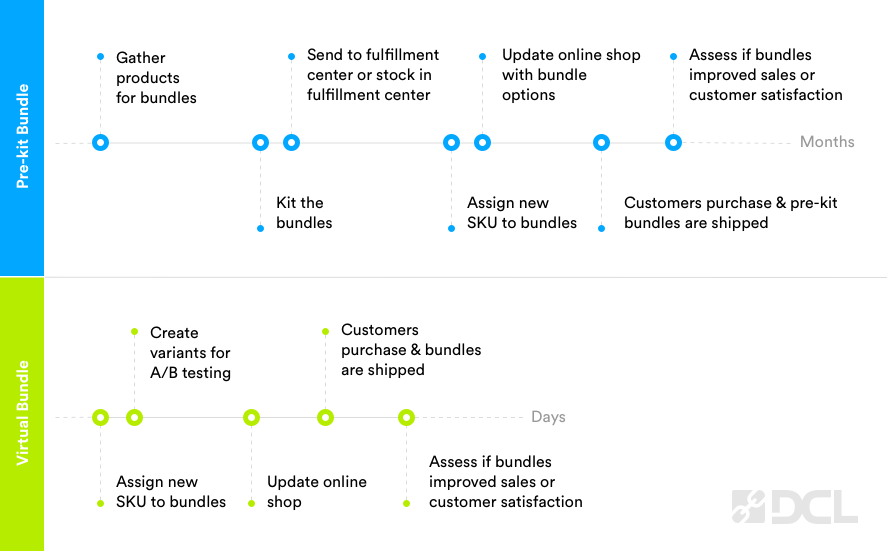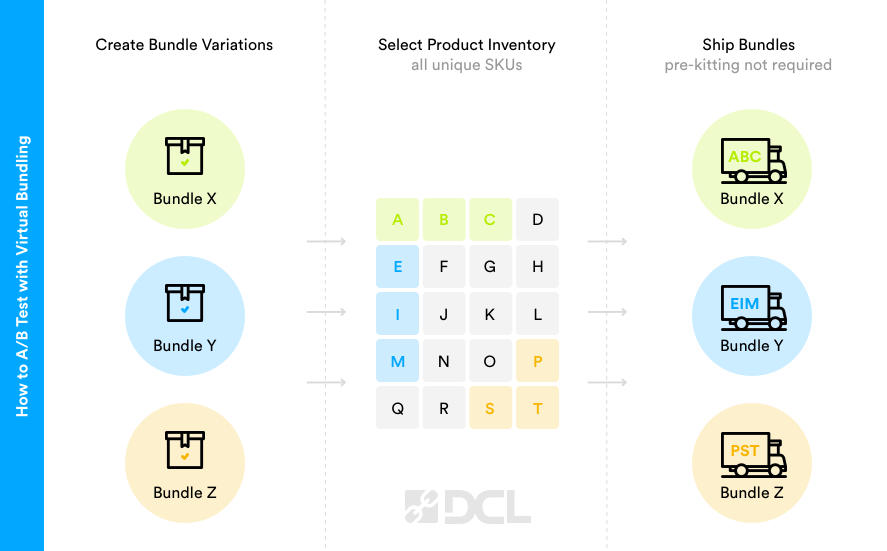
Fulfillment bundling is a tactic used when multiple products are sold together, in the same package, and together those items have a single SKU assigned to the bundle. In recent years, technology and automation have made bundling much easier to accomplish operationally. It’s now a competitive advantage—especially for sellers looking to increase their average order value—to offer their customers specialized assortments of their products.
What is Bundling in Fulfillment?
From a fulfillment perspective, the difficulty of bundling products comes down to the high level of attention and accuracy they require. The warehouse needs to be able to follow the stock levels of each product in the kit, plus track new assembly orders on-the-fly. Typically sellers would have to choose which products would be bundled together prior to fulfillment and send those pre-bundled items to the fulfillment provider. Alternatively some sellers might have their fulfillment provider build these bundles and create a unique SKU for them.
The Limitations of Pre-Kitted Bundles
While bundling has a lot of benefits, pre-kitting bundles can be costly, financially and in timing. The time it takes to build can slow down the innovation process. For companies building hardware or other manufactured items, a slow supply chain can already be a big hurdle. Ecommerce is growing such that flexibility and speed to market are key to a brand’s success.
- Additional fulfillment cost. Sellers need to account for extra cost to cover the shipping, assembly and labor, plus potential lost revenue (or lost product) if the bundle doesn’t sell as hoped.
- Decreased inventory flexibility. Once items are in bundles, they are not available for individual sale. This can also lead to increased storage fees.
- Limit sales experimentation. Pre-kitted bundles make it difficult to engage in bundling trials. For example, if one bundle is selling better than others, the brand would need to kit more of that bundle, but also push sales of the bundles that aren’t working well so they don’t lose that revenue.

What is Virtual Bundling?
Recently in fulfillment the concept of “virtual bundles” has begun picking up popularity. In essence virtual bundling is when a seller can assign products to a bundle via inventory management software and the fulfillment provider can execute that bundle (and new SKU) as its ordered.
“Being able to bundle products virtually was the biggest lifesaver! Before we could create virtual bundles we had to pre-kit all of our variety pack box options. Between the transit time to get new products to the warehouse and then building the kits, we were struggling to keep up with orders. Creating bundles in eFactory gives our customers the freedom to create any variety option, while giving us much better visibility of our inventory!”
This new method has enabled the expansion of bundling capabilities. For example, at DCL Logistics, our fulfillment software allows sellers to create three different types of bundles.
- Regular bundles—two or more specific items, predesignated to ship as one part number.
- Configured—a set of items that can be added to a single package in any permutation that the end-consumer wants.
- Assembled to Order—designating an item that needs to be assembled with two specific components. This is designed for short-run assembly only as the bundles will be made as the items are received.
Sellers can send just one number (the bundle SKU, not the items specifically) to the warehouse so that those specific components should be picked and packed, or even assembled together for that particular order. This enhancement allows sellers greater flexibility in their order management and a simplified way of offering a wider variety of ordering options for their end-customer.
Benefits of Virtual Bundling
By bundling products customers will be exposed to a wider variety of items. Virtual bundles can improve customer loyalty and promote a unique product mix that may not be available from other sellers. The ultimate benefit for sellers is that bundles increase the perceived value of your products.
Other major benefits to virtual bundling:
- Help offset shipping costs by increasing average order size which leads to greater profits.
- There’s no additional cost to do virtual bundling.
- Create bundles on the fly, which gives you more flexibility

How to A/B Test with Virtual Bundles
One of the biggest benefits of virtual bundling is the flexibility to meet customer needs and iterate quickly. By being able to quickly assign SKUs to new bundles, sellers can easily A/B test which assortments are more popular. It also allows sellers to provide a perceived larger variety of options for their customers.
A company can create different variety packs of their product (think flavors of cereal) by using virtual bundling. These product mixes can be changed for different seasons of the year, holidays, or promotions linked to a new flavor release. The novelty of a new flavor pack, even if it’s a similar assortment as the last flavor pack, might entice some consumers and loyal customers to buy sooner than they would have without the new spin on the product.
For example, a brand might want to test out three different bundles to see which sells the best. Customer A might receive different flavors from Customer B and Customer C. With the data of which sells best the company can more confidently make product choices and grow sales efficiently, faster.

Amazon Seller Central and FBA Businesses
For brand owners who fulfill with Amazon, there is a virtual bundling tool you can use. As of September 2020, sellers can create virtual bundles made up of two to five complementary ASINs which are purchased together from a single detail page. This eliminates packaging items together prior to shipping to the Amazon warehouse, or changing any fulfilled-by-Amazon inbound inventory.

Tags: Articles About Value Added Services








